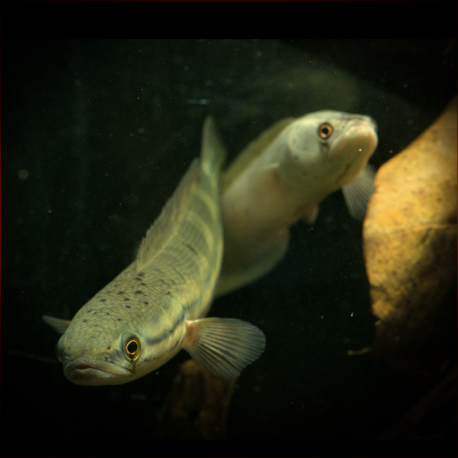More info
Datasheet
| Minimum Tank Size | 10000 litres / 2641.72 US gallons |
| Maximum Size | 48.0cm / 18.90inches |
| Temperature | 22°C / 71.60°F - 32°C / 89.60°F |
| Hardness | 2.02dgH / 36ppm - 20.00dgH / 357ppm |
| pH | 6.0-8.0 |
General Description
The Malabar Snakehead, scientifically known as Channa Diplogramma, is a member of the Perciformes order and belongs to the Channidae family. This species was revalidated in 2011, previously considered synonymous with the Indochinese congener C. micropeltes. It can be distinguished by specific characteristics, including lateral line scale count, body depth, and fin rays. The color patterns on their bodies change as they mature, with juveniles displaying black stripes and orange coloring that transitions to yellow, brown, and later to greyish hues.
Aquarium Setup
Maintaining a species-specific aquarium for the Malabar Snakehead is essential for their well-being. Providing floating or overhanging vegetation and branches for surface cover is appreciated. Unlike most Channa species, the Malabar Snakehead is pelagic and requires ample space to swim. A securely fitted hood is necessary to prevent escapes, with a gap left between the hood and water surface to provide access to a layer of humid air, which is crucial for their breathing apparatus.
Behaviour
Juveniles and subadult Malabar Snakeheads are relatively peaceful among themselves, but they tend to become aggressive upon reaching sexual maturity. It is recommended to keep them in a species-specific aquarium to reduce territorial disputes and aggressiveness. These fish have the ability to breathe atmospheric air, often seen rising to the water's surface to take gulps of air, aiding their survival in hypoxic conditions.
Feeding and Diet
As obligate predators, Malabar Snakeheads feed primarily on smaller fish, amphibians, and terrestrial insects in their natural habitat. In captivity, they adapt well to dead alternatives but should not be solely reliant on dried foods. Young fish can be fed chironomid larvae, small earthworms, and chopped prawns, while adults accept fish flesh, prawns, and mussels. It is crucial to avoid feeding them mammalian or avian meat, as it can lead to health issues due to improper fat metabolism.
Reproduction & Dimorphism
The reproductive behavior of Malabar Snakeheads in captivity is similar to their aggressive nature upon reaching sexual maturity. Male and female interactions intensify during the breeding season. Dimorphism in this species is not as pronounced, with subtle differences in coloration and size between genders. However, their territorial and aggressive tendencies become more evident during the breeding period.
Habitat and Distribution
Endemic to southern regions of the Western Ghats mountains in southern India, the Malabar Snakehead can be found in various rivers and drainages in Kerala and Tamil Nadu states. The species' type locality is in Kochi, Kerala. They prefer habitats with moderate water parameters, including a temperature range of 22-32°C, pH between 6.0-8.0, and water hardness of 36-357ppm.

